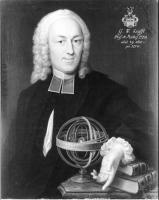| www.tmatlantic.com
Test & Soldering Equipment On-line Store |
|
D.E.V.I.C.E. (Wiki)Calculators Services |
|||||
Filter by first letter
|
Invention of a "simple" voltmeter
It is believed that the first voltmeter was invented by M. Faraday, in 1830, a year before he discovered the phenomenon of electromagnetic induction, on which the operation of a whole class of electrical measuring instruments is based, and half a century before the adoption of the voltage unit “volt”. Interestingly, no drawings of this voltmeter could be found.
However, there is a description of the invention by a German physicist I. Schweiger, who in 1820 invented the prototype of these devices - the galvanoscope. It consisted of one turn of wire, inside of which a magnetic needle was placed. When current passed, the needle deviated by a certain angle, by which some electrical indicators were judged. And in 1839, our Moritz Jacobi calibrated a galvanometer, which previously simply indicated that there was “something” in the circuit, in order to quantitatively measure the parameters of electric current. However, the very first voltmeter, as it were, was still the “indicator of electrical force, or electrical weight” by the Russian physicist Georg Wilhelm Richmann (1745). He measured electricity precisely on balances, small lever scales, the balance of which was disturbed due to the deviation of one of the cups due to electrostatic interactions (after all, Faraday had not yet discovered electromagnetic interactions). In 1781, Alessandro Volta invented electrometers using elderberry beads and, in an improved model, light dry straws. Only a hundred years later, engineer Jacques d'Arsonval made a magnetoelectric galvanometer, in which the movable element with a pointer was a conductor (coil) carrying current, placed in the field of a permanent magnet. Perhaps every prominent electrical scientist and practical engineer made his contribution to the development of instruments for measuring electrical quantities. For example, in 1884 A.N. Yablochkov proposed his version of the ammeter. M.O. Dolivo-Dobrovolsky developed electromagnetic ammeters and voltmeters, an induction measuring mechanism with a rotating magnetic field and a moving part in the form of a disk, and used it in a wattmeter and a phase meter. But all those electrical measuring instruments could be called “voltage meters”. Since only in 1881, at the first international electrotechnical congress, standards for basic electrical quantities were adopted, which immortalized the names of Ampere, and Volt, Ohm, and Weber and Gauss... And only after that, in the same 1881. German engineer Friedrich Zippenbohn rightfully called his device for measuring voltage a voltmeter. Today we have made great progress in measuring electrical quantities with instruments based on the coexistence of the aforementioned elderberry balls, arrows, coils and springs in an environment of interacting magnetic and electric fields - the foundations were laid back then. And the magnetoelectric system, as before, is a permanent magnet with a steel frame located in its interpolar space. And the electromagnetic system is still a fixed coil and a moving core. Electrodynamic - two coils, moving and fixed, both connected to the network. Induction with its disk is known to everyone who promptly pays housing and communal services for consumed electricity. Since the time of Richmann's scales, the electrostatic system has been used as a particularly precise device, which today is based on a fixed chamber-electrode, into which a movable electrode with a mirror is moved, a ray indicating on the scale how much electricity is weighed in volts. And in 1922, the first electronic voltmeter with a measurement limit of 9.8 V was created in Cambridge. A laboratory assistant who attempted to use a unique device at 11.3 V was deprived of a quarterly bonus. |
Site mapPrivacy policyTerms of Use & Store PoliciesHow to BuyShippingPayment




|

























